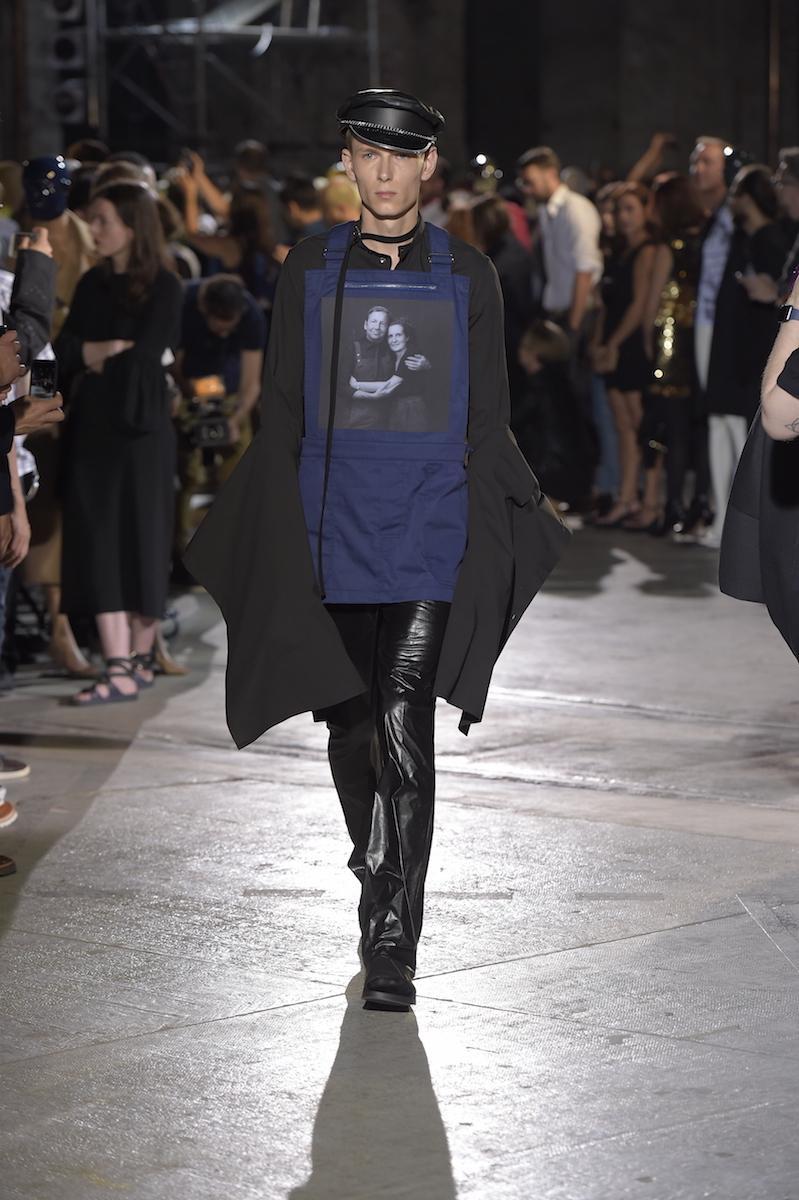Last week, Comme des Garçons teamed up with Vetements on a limited-edition capsule collection of sweaters. Teased on Instagram, the “gay, lesbian, and fetish” range was sold as a Dover Street Market exclusive with the “fetish” design selling out online shortly after launch. The piece, priced at $620, nodded to a very specific community.
In 1989 Tony DeBlase, founder of the Leather Archives & Museum in Chicago and publisher of Drummer magazine debuted a flag design for the leather community at the International Mr. Leather competition. (The leather community places an erotic emphasis on leather garments — including vests, chaps, and caps — which also serve as signifiers of their subculture and sexual practices.) Replete with nine stripes of black, blue, and white with a heart in the upper lefthand corner, DeBlase’s flag went on to represent the entire leather community — not just the queer leather community — and is still featured prominently at popular leather events like the Folsom Street fairs. Now, that design has been turned into a CDG sweater. But this latest coveted piece is just one part of fashion’s complicated relationship with the leather community.
In 2016, independent leather designers and stores like Zana Bayne and the Leather Man grew their cult fashion followings. And on the runways, Raf Simons referenced the subculture in his spring/summer 17 collaborative collection with the Robert Mapplethorpe Foundation. The show featured models wearing thin leashes as well as Muir caps (black leather biker caps), which are closely associated with the leather community. But there’s a difference between using leather props and accessories to style out your show and appropriating the community’s sacred iconography.
“There’s two different types of people,” John-John Punki, the current Mr. Eagle NYC (the reigning leatherman of New York’s premiere leather bar Eagle), tells i-D. “There’s leather people and then there’s people who like leather for fashion. When I was putting on a leather harness [for the first time] I didn’t know what message I was sending; whoever puts leather on, don’t get me wrong you feel sexy and you feel powerful. I just hope people take the time to realize there is a whole community behind it and it means a lot to a whole group of people.”
Like many communities, the leather community is one built on tradition. “I was introduced to leather the traditional way,” says Justin Terry-Smith, vice-president of the Onyx mid-Atlantic chapter. Onyx is a popular leather organization for people of color. “I was taught by a daddy and I didn’t receive my first piece of leather until he thought I had earned it.” According to Smith, an Air Force veteran himself, the basis of the community has roots in the military; it values protocol, loyalty, and service before self.
“It’s basically been a law that the leather community has very many traditions and we have held strong to them,” Smith explains. “A lot of them have been pushed to the wayside so you get these guys in gear and they think they are leathermen. I’m like, ‘You might be kinky but you might not be a leatherman.'”
For those involved in the community, being a member means more than wearing a harness or another type of gear. For Punki it involves a sense of family. Alaina Hummel, the current Ms. Philadelphia Leather agrees; she says it’s about a sense of community and looking out for one another. So when the mainstream fashion industry uses symbols sacred to the community for their aesthetic appeal, it can be a bit of a conundrum.
“I’m all for anything that gets people involved but some people in the community are a little judgemental about that,” Hummel says. “When I saw [the CDG and Vetements sweater], right away I loved it. I think in general the reaction from most of my leather friends was that they genuinely liked it.” But do wearers of the sweater know what they’re putting on? It would be easy not to realize that the design is a flag at all, unless you were familiar with its colors and heart already.
“A lot of people might be wearing it and not even know what this even is,” Damien Basile, a fashion designer and leatherman says. Basile and Hummel agree that though the leather flag has a large presence within the leather community — appearing as pins and on vests and corsets — it isn’t as commonplace outside of the community. “Also, the thing is that this flag is specifically for leather; this isn’t a catch all for fetishes. There’s a different flag for rubber,” Basile adds. (The CDG and Vetements sweater was marketed simply as a “fetish” design.)
Both Basile and Hummel seem impressed with the project and are fairly optimistic that the fashion fans who purchase the piece will be knowledgeable about what it stands for. “With that price, people would probably research it before they buy it,” Hummel reasons.
And for those who don’t educate themselves, wearing the piece will hopefully provoke a worthwhile conversation with someone in the community. “People might just want to pick up the sweater because it’s hot and it’s like, ‘Do you want me to teach you what that means?'” Onyx chapter vice-president Terry-Smith says. “If not, it just tells me you’re an ignorant asshole.” Punki suggests that, in the future, brands add a hang tag explaining the iconography their pieces are using — to acknowledge the communities they are honoring. It’s a small addition that would ensure brands sidestep the much-discussed industry problem of subcultural appropriation.
Credits
Text Mikelle Street
